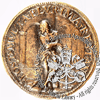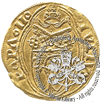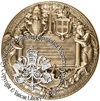Department of the Numismatic Cabinet
The Numismatic Cabinet or Medagliere of the Vatican Library preserves coins, medals, seals, plaquettes, plaques, engraved stones, casts, and other similar materials.
It also keeps the official pontifical medals and coins.
The collection includes about 300,000 pieces.
The work of the Department consists of inventorying, classifying and cataloguing this material, and making it available to scholars.
The Catalogue of coins and medals is available on-line.
HISTORY OF THE VATICAN MEDAGLIERE
The origin of the Vatican Medagliere is generally believed to go back to Pope Marcellus II (1555), who, when he was still Cardinal Librarian, is said to have donated his collection to the Vatican Library.
It was made up of many rare pieces, including a large number of ancient coins.
In fact, however, it is not until the pontificate of Clement XII Corsini (1730-1740) that we find the beginnings of a numismatic collection worthy of the name in the Medagliere of the Vatican Library.
In 1738, Clement XIII acquired the famous collection of 328 Greek and Roman medals which belonged to Cardinal Alessandro Albani, especially for the Vatican Medagliere, which had been relatively neglected up until then.
The same access restrictions as had been established by Sixtus V for books and manuscripts were applied to this fundamental nucleus of medals, and one can say that it is from here that the entire history of
the pontifical Medagliere had its beginnings.
Between 1741 and 1743, Pope Benedict XIV Lambertini decided to acquire another famous collection, that of Cardinal Gaspare Carpegna, which included not only coins and medals, but also thousands of tesserae, cameos, small bronzes and jewels.

 The work of inventorying this immense collection lasted for almost two years; but in 1743, Msgr. Giuseppe Simone Assemani, "Primo Custode" of the Vatican Library and a keen numismatist who had already compiled
the inventory of the Albani collection, was able to add the over 4,000 pieces of the Carpegna collection to the Medagliere.
The work of inventorying this immense collection lasted for almost two years; but in 1743, Msgr. Giuseppe Simone Assemani, "Primo Custode" of the Vatican Library and a keen numismatist who had already compiled
the inventory of the Albani collection, was able to add the over 4,000 pieces of the Carpegna collection to the Medagliere.
A few years later, again upon the initiative of Pope Lambertini, the no less famous collection of about 5,000 pontifical coins which had belonged to the well-known numismatist Saverio Scilla became part of the Vatican Medagliere.
This collection included a number of unique pieces; the Pope had cases constructed out of walnut wood in order to provide a fitting home for the entire numismatic collection.
His successor, Clement XIII Rezzonico (1758-1769) incorporated the Vatican Medagliere into the Christian Museum of the Library and enriched it with about 150 gold coins of exceptional rarity which had been found in
the Sacred Treasure (Erario Sanziore) of Sixtus V in Castel Sant'Angelo. The remarkable artistic sensitivity of this pontiff, and of the cardinals whom he chose as librarians, resulted in the enlargement of
the Vatican Medagliere to include many precious pieces such as the complete series of pontifical medals in silver, struck from the dies which belonged to the famous Hamerani family of engravers.
But it was the nomination of Giovanni Elia Baldi as "Prefect" of the Christian and Secular Museums of the Library, on June 1, 1770, according to the express wishes of Clement XIV Ganganelli (1769-1774), and his resulting responsibility
for the numismatic collections contained in these Museums, which marked the decisive turning point in the history of the Medagliere. Though these collections already held a large number of pieces, they were kept in a
rather disorderly jumble (with the exception of the Albani and Carpegna collections, the only ones for which there was at least a cursory inventory). Baldi began the process of cataloguing this material and organizing it in a coherent way.
He also put in place a scheme of exchanges with other museums, with the approval of the pontiff. As a direct consequence of this, the decision was made to purchase the collection of Greek and Roman coin of Simone Ballerini, with almost 3,000 pieces,
among which Baldi chose the best ones; many other more or less rare coins and medals arrived at the Medagliere as a result of donations from private individuals.
The elevation to the throne of Peter of Pius VI Braschi (1775-1799), a man of refined taste, brought about a further enlargement of the Vatican numismatic collections. This pontiff not only transferred to the Medagliere a large number of
very rare coins from his own private collection, he also sent there all the coins which were discovered during the drainage works in the Pontine Marshes.
 Pius VI was so interested in the Medagliere that he decided to give it a new home with magnificent furnishings designed by Valadier.
However, Pope Braschi's greatest act in favor of the Medagliere was no doubt the purchase, in 1794, of the collection of Queen Christina of Sweden, which had already been universally admired in the preceding century and to which had been added,
at the beginning of the eighteenth century, the no less famous Odescalchi collection.
Pius VI was so interested in the Medagliere that he decided to give it a new home with magnificent furnishings designed by Valadier.
However, Pope Braschi's greatest act in favor of the Medagliere was no doubt the purchase, in 1794, of the collection of Queen Christina of Sweden, which had already been universally admired in the preceding century and to which had been added,
at the beginning of the eighteenth century, the no less famous Odescalchi collection.
At the end of the eighteenth century, when the French troops of General Berthier had seized Rome, they began a systematic plundering of the Vatican Library. Not only its manuscripts, books, and works of art, but also its numismatic collections were
indiscriminately gathered into hemp bags and sent to Paris, where they arrived between 1798 and 1799. The Vatican Medagliere had practically ceased to exist.
July 1800 saw the arrival in Rome of the new pontiff, Pius VII Chiaramonti (1800-1823). He arrived from Venice, where he had been elected in a conclave presided over by Austrian troops.
 In spite of the many political and administrative preoccupations which were forced upon him by those tragic times,
Pius VII decided to purchase the splendid collection of P. M. Vitali, which consisted mostly of Roman coins. Even as he was being dragged into exile, the Pope himself, fearing that this collection would be taken by the French,
entrusted it to Canova so that he could hide it in his home.
In spite of the many political and administrative preoccupations which were forced upon him by those tragic times,
Pius VII decided to purchase the splendid collection of P. M. Vitali, which consisted mostly of Roman coins. Even as he was being dragged into exile, the Pope himself, fearing that this collection would be taken by the French,
entrusted it to Canova so that he could hide it in his home.
The French domination from 1809 to 1814 did not bring about any further losses for the Vatican Medagliere. On the contrary, it slowly began to receive new material, thanks mostly to the many coins which came out of the ground during archaeological excavations in Rome and the surrounding area during those years. The staff of the Library vigorously defended the collection against any further attempts at removal, so that Pius VII was able to note with satisfaction, upon returning to Rome, that the Medagliere had once again grown to possess a fair number of pieces.
 After the definitive decline of Napoleon, Canova was sent to Paris together with Msgr. Marini to demand the restitution of all the objects which had been
plundered from the Vatican Library, including the Medagliere. Unfortunately, there was no complete descriptive inventory of the numismatic collections which had been moved from the Vatican to the banks of the Seine, so the pontifical delegation had to
be content to receive the same number of coins, but not necessarily the same ones which had come to Paris in 1798 and 1799.
After the definitive decline of Napoleon, Canova was sent to Paris together with Msgr. Marini to demand the restitution of all the objects which had been
plundered from the Vatican Library, including the Medagliere. Unfortunately, there was no complete descriptive inventory of the numismatic collections which had been moved from the Vatican to the banks of the Seine, so the pontifical delegation had to
be content to receive the same number of coins, but not necessarily the same ones which had come to Paris in 1798 and 1799.
 However, the recovered material, together with the Vitali collection and the small "Roman" nucleus which had come from the excavations, was arranged in the Chapel of
St. Pius V, next to the Library, in old cabinets; and a complete inventory was finally made by Giuseppe Baldi, the son of Elia, and by Bartolomeo Borghesi.
However, the recovered material, together with the Vitali collection and the small "Roman" nucleus which had come from the excavations, was arranged in the Chapel of
St. Pius V, next to the Library, in old cabinets; and a complete inventory was finally made by Giuseppe Baldi, the son of Elia, and by Bartolomeo Borghesi.
In the meantime, it was above all the tireless labor of Baldi which soon brought the Vatican Medagliere to increase its holdings; his task was facilitated by the establishment, by Pius VII, of a commission "for the purchase of works of art"
which was made up of a group of eminent scholars including Canova himself, Filippo Aurelio Visconti, Carlo Fea, and Thorwaldsen. The pontiffs who succeeded Pius VII continued to increase the holdings of the Vatican Medagliere; and finally,
after the hiatus of the Roman Republic, Pius IX Mastai Ferretti (1846-1878) named its first "Keeper" (Custode) in the person of Fr. Tessieri, a distinguished numismatist who had been curator at Kircher's Museum. It was thanks to the insistence of
Fr. Tessieri that the Vatican Medagliere was able to receive in its cabinets the collection of Andrea Belli, which included many pontifical coins from the medieval and modern periods. Another important purchase was the acquisition in 1854 of
the collection of Roman Republican coins which had been gathered over about twenty years by Francesco Sibilio and which included 33 gold coins, more than 3,000 silver coins, and almost 1,000 bronze coins.
At Tessieri's death, in March 1873, the Vatican Medagliere held many thousands of pieces; and the number continued to grow under his successors, especially under Carlo Ludovico Visconti and Camillo Serafini. At the beginning of the new century,
Serafini had the pleasure of seeing the arrival in the Medagliere of Cardinal Lorenzo Randi's extraordinary collection of over 26,000 pontifical coins.
After the First World War, Pius XI, who was himself a distinguished numismatist, with the collaboration of Serafini, enriched the Medagliere with a large number of Greek and Oriental coins, but also with many other pieces, often extremely rare ones;
the collection of medals was enlarged particularly thanks to the bequest of the collection gathered by the expert numismatist Luigi Pizzamiglio, which also included dies, punches and a large technical library.
In most recent times the Medagliere has grown further, especially by additions of pontifical and other modern medals, thanks to donations: among these, we mention the donations of the medals by Luciano Zanelli, Laura Cretara, Angelo Grilli, Guido Veroi, Pierino Monassi, Maria Adele Piccirilli, made by the artists themselves; the donations of the medals created at the factories Lorioli and Pagani, the donation of the medals, coins and plasters by Pietro Giampaoli, of the medals by Enore Pezzetta, by Erminio Varisco made by the respective heirs.

 The collections which today distinguish the Vatican Medagliere and are its main source of pride are certainly those of pontifical coins, of pontifical medals and of Roman coins, especially from the Republican period. However,
other collections are also important and contain many rare or even unique pieces, in particular the collections Greek, Byzantine, Medieval and Oriental (especially Chinese) coins. Also noteworthy are the collections of pontifical and Byzantine lead
seals (or "bulls"); of Roman lead tesserae; of over 10,000 plaster, glass or sulfur casts of medals and gems; of 800 engraved Roman gems; of pontifical, Italian, and other decorations. The technical library is also rich in books, many of which are old or rare,
and which complete the numismatic collection of the Popes, one of the world's richest collections and certainly its most famous one.
The collections which today distinguish the Vatican Medagliere and are its main source of pride are certainly those of pontifical coins, of pontifical medals and of Roman coins, especially from the Republican period. However,
other collections are also important and contain many rare or even unique pieces, in particular the collections Greek, Byzantine, Medieval and Oriental (especially Chinese) coins. Also noteworthy are the collections of pontifical and Byzantine lead
seals (or "bulls"); of Roman lead tesserae; of over 10,000 plaster, glass or sulfur casts of medals and gems; of 800 engraved Roman gems; of pontifical, Italian, and other decorations. The technical library is also rich in books, many of which are old or rare,
and which complete the numismatic collection of the Popes, one of the world's richest collections and certainly its most famous one.
ACCESS TO THE NUMISMATIC DEPARTMENT
To gain access, readers must:- a) request a reader's ticket giving access to the Library, at the Admissions Office;
- b) call the Numismatic Cabinet to fix an appointment;
- c) go to the entrance of the Library, from where they will be accompanied to the Numismatic Department, after they have handed in their reader's ticket, received a key and placed their personal belongings in a locker;
- d) sign the register of readers in the Numismatic Department, indicating the time of arrival and of departure.
CONTACT DETAILS
- CURATOR Dr. Eleonora Giampiccolo: contact by email
- Telephone: +39/06698.79406
- Fax: +39/066987.9428
- OFFICE: contact by email





